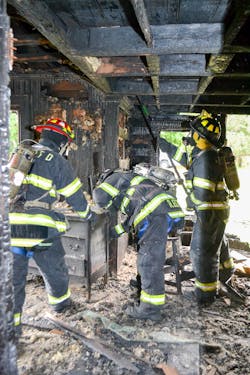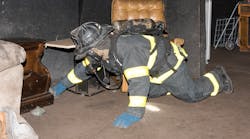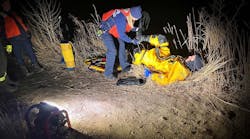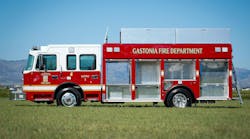The incident commander (IC) receives a radio transmission from the first-due engine company officer: “The main body of fire has been knocked down.” Shortly thereafter, the first-due truck company officer reports, “Primary search is complete and negative on the fire floor.” As the officer of the second- or third-due truck company, you are then given the order to conduct a secondary search.
Last month we covered the primary search, from basic steps and search positions to radio transmissions and key tools. The primary search is methodical and conducted as quickly as conditions warrant. While conducting the primary search, fire conditions can be severe, with limited or no visibility. The primary search is critical for fire victim survival.
Here we’ll discuss the secondary search, which is performed at a slower pace, when the fire is under control and visibility is not a factor. It is vital that the search be thorough.
Painstakingly thorough
The mission for the primary search is to locate victims, and locate and confine the main body of fire. The mission of the secondary search is to locate any unaccounted-for victims. On completion of the secondary search, the worst possible scenario is to learn that the fire department missed a victim. Fire victims have been found days later by workers cleaning up the fire scene.
One instance that comes to mind is when a 30-year veteran fire officer was given the task to conduct a secondary search in a two-story private dwelling. The company completed the secondary search with negative results. When the owner arrived at the fire scene, he stated that his 8-year-old child was home at the time of the fire. The child was still unaccounted for at the time. The fire officer assured the IC that the secondary was complete and negative.
Two days later, the little boy’s body was recovered. The body was wedged between the entertainment center and the wall. The search team did not move the entertainment center away from the wall, and assumed that the space was too small for the boy to fit behind. Every possible space must be visually searched, and the search team must never make assumptions.
Search complexity
The secondary search is a task that can take 10 minutes or 10 hours depending upon the extent and severity of the fire. A secondary search of a simple one-room contents fire can often be accomplished in 10 minutes, whereas a secondary search of an 8- or 10-room private dwelling with extensive fire throughout can take hours. Conducting a secondary search of a large multiple dwelling with several stairwells with fire on multiple floors can be quite extensive and take a long time to complete.
Some factors that can affect the complexity of the secondary search include:
- Type of occupancy/building size: Consider the different issues involved in searching three rooms in a two-story garden apartment, a 2,000-square-foot eight-room apartment in a 24-story high-rise multiple dwelling, a 1,200-square-foot ranch-style home built on a slab, a 4,000-square-foot 2½-story private dwelling with a finished cellar, a one-story taxpayer and a five-story 50,000-square-foot factory/warehouse.
- Construction: Whether it’s Type I fire resistive or Type IV heavy timber, each construction type presents different fire and smoke travel/extension, thereby making some areas of the building part of the IDLH. A fire in a Type V building will have more potential for fire travel than a Type I building. Each building will present different challenges. Type I buildings may have multiple stairways and elevators to search whereas a Type IV warehouse will have large areas to search.
- Fire severity: Is it a minor one-room fire or are multiple rooms or floors involved? As the fire grows, so does the amount of smoke and fire extension, thereby exposing more areas to the products of combustion—victims possibly becoming overcome.
- Cluttered conditions: When we conduct a secondary search, our objective is to search until we reach the floor or reach a wall. I have encountered cluttered occupancies where contents have literally been stacked to the ceiling. Cluttered conditions can clearly amplify the amount of time required. Removing the contents to reach the floor is extremely time-intensive and laborious.
- Collapse areas: When we encounter areas of the building involved with structural collapse, this can greatly complicate the secondary search effort. The area must be made safe before we can conduct the search. Collapse protocols must be followed, and this involves structural shoring operations.
- Personnel: Whenever possible, the secondary search should be performed by personnel who did not conduct the primary search. A fresh company of firefighters is preferable with a fresh set of eyes, as this will lessen the possibility that a victim will be missed again. If staffing is limited, one option is to redeploy crews to areas that they did not search on the primary. If crew A did a primary on the fire floor and crew B did a primary on the floor above, then crew A can do the secondary on the floor above and crew B can do the fire floor.
Key steps/points
There are several key points in conducting a secondary search that will aid in thoroughness and professionalism.
Proper PPE must be worn: Just because the fire is in the post-control phase does not mean that the air is safe to breathe. Deadly gases and carcinogens are still present. This includes asphyxiants like carbon monoxide, carbon dioxide and hydrogen cyanide as well as organic irritants, such as acrolein, formaldehyde, crotonaldehyde, benzene, phenol and styrene, just to name a few. Helmets and full PPE must be worn during the secondary search.
Pay attention to witnesses: If an occupant, neighbor or witness states that they know someone was in the building, we must make all efforts to search and investigate. All occupants must be accounted for before the fire department leaves the scene and the building is turned over to the owners.
Be methodical and coordinated in search efforts: The secondary search may begin at either the fire area or from the entrance of the building or apartment. It is often easier to begin in less affected areas than in the area where the main body of fire occurred. In the immediate fire area, crews may still be conducting overhaul, and opening ceilings to expose hidden fire extension.
Go down to the floor: In a primary search, we do not like to move furniture, appliances or large objects. We use these items as landmarks to stay orientated to room layout to prevent getting lost or turned around. During the secondary search, we must move furniture away from walls, lift beds (and even throw mattresses out windows), move refrigerators away from walls, etc. We must move all boxes, clothes and any other content that may conceal and hide a victim. It may be necessary to use shovels and garbage cans to remove the debris.
Examine closets/cabinets/drawers/bathtubs: Anywhere someone can fit must be thoroughly examined. Fire victims often seek refuge in closets and the bathroom. Remember when searching closets, remove ALL contents (clothes, shoe boxes, luggage, etc.).
Expand the search: It is important to search ALL areas of the building. This includes floors above and below, stairwells, elevator shafts and the roof. Search the outside perimeter of the building. Fire victims jump out windows to escape fires, so make sure to thoroughly search bushes and shrubs. Search rear or side setbacks and exposure roof tops. Don’t forget below-grade areas and cellars. There can be large amounts of water present. Before a secondary search can be deemed complete, if the water is deep, the cellar must be pumped out to be sure.
Final thoughts
In baseball, if a player has a batting average of .350, he is doing great. For us, though, our average must be a perfect 1.000 at every fire when it comes to locating victims. We are professionals, career or volunteer. Remember, when we are conducting a secondary search, time is our ally; we must get it right. The search must be painstakingly thorough. The next time you give the IC a report that the “secondary is complete and negative,” remember the key points. Stay low!







